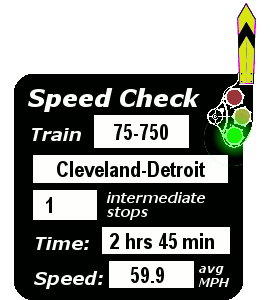PARLOR,
SLEEPING AND DINING CAR SERVICE WESTBOUND
No. 75—The
Mercury—Daily.
Streamlined,
Completely Air-Conditioned. All seats reserved.
Lounge Car...Cleveland to Detroit—Buffet.
Parlor Cars...Cleveland to Detroit—Observation—Cleveland to Detroit.
Dining
Car and Coaches...Cleveland to Detroit.
Regularly
assigned cars are air-conditioned.
PARLOR,
SLEEPING AND DINING CAR SERVICE EASTBOUND
No. 76—The
Mercury—Daily.
Streamlined,
Completely Air-Conditioned. All seats reserved.
Lounge Car...Detroit to Cleveland—Buffet.
Parlor Cars...Detroit to Cleveland—Observation.
Detroit to Cleveland.
Dining
Car...Detroit to Cleveland.
Coaches...Detroit
to Cleveland.
Regularly
assigned cars are air-conditioned.
EQUIPMENT—Detroit Branch.
THE
MERCURY. (No. 75-750 and No. 761-76). Streamlined—Air Conditioned.
All seats in coaches as well as parlor cars are reserved; individually
assigned in advance and sold by number.No. 75-750—Lounge Car, Parlor Car, Parlor-Observation Car, Dining Car and Coaches
Cleveland to Detroit.
No.
761-76—Lounge Car, Parlor Car, Parlor-Observation Car,
Dining Car and Coaches Detroit to Cleveland.
4915
or 4916 Streamlined K5 4-6-2 Pacific
Locomotive and Tender
1001
Baggage 52 Revenue seat Coach Combination
1002
60 Revenue seat Coach
1003
18 Revenue seat Coach – Kitchen Car
1004
62 seat Dining Room Car
1005
56 Revenue seat Coach
1006
56 Revenue seat Coach
1015
TOLEDO
31 seat Tavern Lounge Car
1017
CLEVELAND
25 Revenue seat Parlor Car
1019
DETROIT
26 Revenue seat Parlor 10 seat Lounge Observation









In the mid-1930s the New York Central retained industrial designer Henry Dreyfuss with an eye to developing its first streamliner. Dreyfuss's plans were approved but when the railroad's management saw the final price tag, they balked. A disappointed Dreyfuss, taking a train out of town, saw a group of old surplus commuter coaches sitting in the yards at Mott Haven and had an idea. Shortly thereafter, the Central began rebuilding a group of the old cars to Dreyfuss's designs, while Dreyfuss busied himself with planning every detail from the locomotive to the dining car china. A new, tight schedule was adopted which trimmed five stops and a full hour off the running time of the previous train on this route. The Mercury of 1936 was the result.